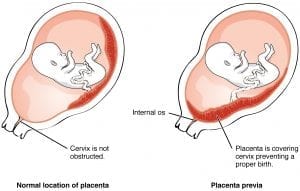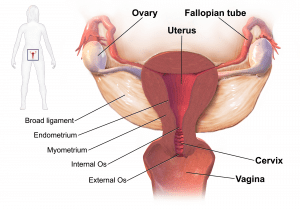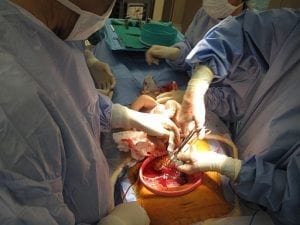Placenta previa is not on the list of common complications of pregnancy (1 in 200 pregnant women). It happens when the placenta blocks a portion of the whole opening of the cervix, leading to abnormal birth.

As you and your spouse adamantly wait for the coming of your greatest blessing, it’s usual to feel worried and afraid, especially the first time mothers. They are anxious to know whether their baby is healthy or if it has some complications. That is why appropriate prenatal visits must be done to avoid further problems. Nevertheless, pregnancy issues may still occur despite being careful, so it would help women learn and educate themselves on what to anticipate.
The Placenta Described

The placenta is a thick organ that develops when a woman gets pregnant. It is round and flat, and it is connected to the baby through the umbilical cord. The placenta places a crucial role in the normal growth process of the fetus, as it is responsible for providing it with the necessary oxygen and nutrients. It is its first line of defense against bacteria and other foreign substances that may attempt to enter into the mother’s womb. It also produces specific hormones and functions to excrete the baby’s waste out of its system.
Possible Complications And How To Prevent Them

Placental problems sometimes are inevitable for pregnant women, and often, not much can be done to avoid these problems. However, there are things you can get rid of to lessen the possibilities. These include smoking and drug abuse.
Going to prenatal appointments is also a must, as this can very well go a long way in discovering early signs of complications.
If women experience issues such as vaginal bleeding, abnormal uterine contractions, and severe back or abdominal pain, they are to contact their obstetrician immediately.
Placenta Previa Defined
Under normal circumstances, the placenta is connected above or at the side of the uterine wall and far from the cervix. If it does attach to the cervix either partially or completely, then we have a condition known as placenta previa.
During the first three months or about 28 months into the pregnancy, the location of the placenta doesn’t play a crucial role, as the uterus normally changes shape and location as the pregnancy continues. Most of the time, this is fixed when the delivery time is nearing. The uterus normally pulls the placenta upward and further from the cervix to prevent the baby from being blocked as it exits the vagina.
If, however, on the 3rd week, the placenta is still blocking the cervix, then it may no longer move upward. And when this happens, the doctor recommends the woman to undergo a cesarean section.
Symptoms Of Placenta Previa
Placenta previa can consequently lead to continuous vaginal bleeding throughout the pregnancy. What’s worse is that the bleeding has no accompanying pain, and it worsens in the last trimester. It the woman is allowed to undergo labor, further bleeding may occur. The reason for this is that the dilatation of the cervix forces the placenta to be pulled further away from the uterine wall, which is why a cesarean section is most often the procedure of choice for this condition.
Important symptoms seen as possible proof of placenta previa include:

- Premature contractions
- A diagonal or breech position of the unborn baby
- Larger than usual size of the uterus during the pregnancy
Types of Placenta Previa
The three main types include:
- Complete placenta previa, which occurs when the organ is completely covering the vaginal canal from the uterine wall to the cervix.
- Partial placenta previa, which occurs when the placenta is only covering a portion of the birth canal.
- Marginal placenta previa, which occurs when the organ is located at the borders, though not covering the birth canal.
The term low-lying placenta is interchangeably used to refer to marginal placenta previa and placenta previa. Additionally, posterior placenta previa and anterior placenta previa are used to describe the precise location of the placenta concerning the uterus.
Management And Treatment Of Placenta Previa
The treatment of this condition will depend on the severity of bleeding, the location of the fetus and placenta, and its gestational age.

The C-section is highly recommended for those who have complete placenta previa, and possibly for the other types of placenta previa as well. The Cesarean section is a planned procedure for pregnant women who have placenta previa. It is usually done after the 36th week, but possibly earlier in case of heavy bleeding that is impossible to be stopped and may cause danger to the mother and the baby.
If bleeding can be controlled, then the doctor would recommend complete bed rest until delivery, with an important note that medical care should always be easily accessible in case bleeding resumes. Exercise and sexual intercourse are also to be avoided in the last three months of pregnancy.
Those with placenta previa and are suffering from excessive bleeding are recommended by their doctors to have IV fluids and blood transfusions. Medications such as magnesium sulfate, Brethine, and corticosteroids may also be given to maintaining normal fetal lung development before undergoing a cesarean section.
Conclusion

It has been said that prevention is better than cure, and it’s better safe than sorry. These hold for all pregnant women who are anticipating the arrival of their baby. Placenta previa can be bothersome and may even be perilous in some cases, but is manageable – with your doctor’s help and with appropriate self-care. Unfortunately, you will have to deliver through C-section, but if this means delivering a healthy, happy, and bouncing baby, then it’s all going to be worth it.
FAQ
What is placenta previa?
As explained also in Healthline.com, placenta previa happens when the baby’s placenta is covering fully or partially the mother’s cervix. It may cause bleeding without pain during pregnancy.
What causes placenta previa?
The main cause of placenta previa is unknown. But this usually happens to those who have given birth already, or when you have scars in your uterus due to previous operations, who are age 35 or older, or if you smoke.
How is placenta previa diagnosed?
Placenta previa is diagnosed through ultrasound. A routine prenatal ultrasound may help know that you have a placenta previa. You may be asked to undergo a transvaginal or abdominal ultrasound to make sure of the status of your baby inside the womb.
Is placenta previa considered high risk?
Yes, placenta previa can be considered high risk, most especially if the bleeding is consistent. You can also be scheduled to have a caesarian section if you are nearing your delivery due date, and the placenta is still covering the cervix.
Does placenta previa require bed rest?
If you are experiencing placenta previa with minimal bleeding or no bleeding at all, the doctor may advise you for some bed rest. But if it involves constant bleeding, you should consult your ob gyne for efficient medical care.
Is placenta previa considered high risk?
If placenta previa is discovered in the early trimester, there may still be a chance that the position of the placenta may move and will be resolved. But if it’s discovered late in your pregnancy, you may be advised to undergo c section during delivery.
Does placenta previa require bed rest?
Yes, you may be required for a bed rest if you are experiencing placenta previa. But if you are bleeding, you may need more medical attention.
What should you not do with placenta previa?
When you have placenta previa, you are required to avoid physical activity to prevent bleeding. You should not also put anything in your vagina like tampons. You should also avoid smoking.
What could happen with the fetus during the placenta previa?
During labor, your cervix will thin out and dilate to prepare for birth. But if you have placenta previa, the dilation of the cervix may cause bleeding because the blood vessels connecting the placenta and the uterus may tear up and may cause severe bleeding. When this happens, you and the baby are in danger.
Can you work with the placenta previa?
If you have placenta previa, you may be advised to leave for work. You may need to rest more so further complications will be prevented like bleeding.
Can you lose your baby with placenta previa?
If you are diagnosed to have placenta previa at the later period of pregnancy, you are expected to be monitored closely by your physician to avoid complications. Generally, women who have placenta previa are scheduled for c section delivery to ensure the safe delivery of the baby.
Does placenta previa mean early delivery?
There is a possibility that you will have preterm labor if diagnosed with placenta previa. This is because placenta previa may cause severe bleeding, so your ob gyne may perform c-section earlier than your expected delivery date.
How common is placenta previa at 20 weeks?
At 20 weeks, it is common for the placenta to be seen in a low position. But the diagnosis of placenta previa may happen between 28-30 weeks because it’s in this period that the ultrasound can be certain if the placenta is already too close to the cervix or now.
Is placenta previa genetic?
According to experts, it is not known if there is a hereditary connection when it comes to placenta previa. There is no scientific evidence if placenta previa is genetic.
Does marginal placenta previa correct itself?
Yes, the good news is that placenta previa can correct itself if diagnosed early. There are instances that if placenta previa is detected at the early stage of pregnancy.
Last Updated on January 11, 2023 by Rejie Salazar
DISCLAIMER (IMPORTANT): This information (including all text, images, audio, or other formats on FamilyHype.com) is not intended to be a substitute for informed professional advice, diagnosis, endorsement or treatment. You should not take any action or avoid taking action without consulting a qualified professional. Always seek the advice of your physician or other qualified health provider with any questions about medical conditions. Do not disregard professional medical advice or delay seeking advice or treatment because of something you have read here a FamilyHype.com.